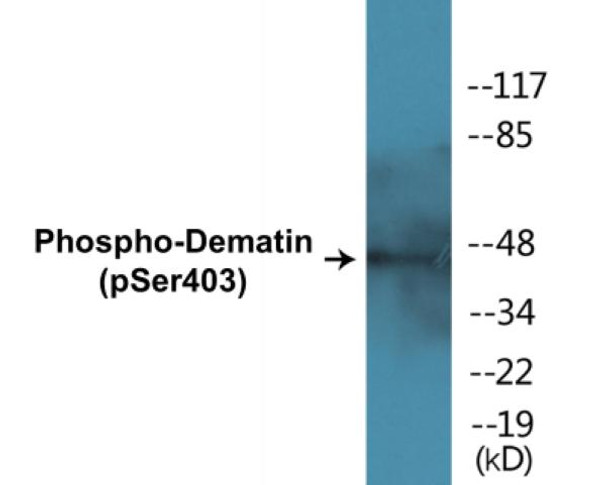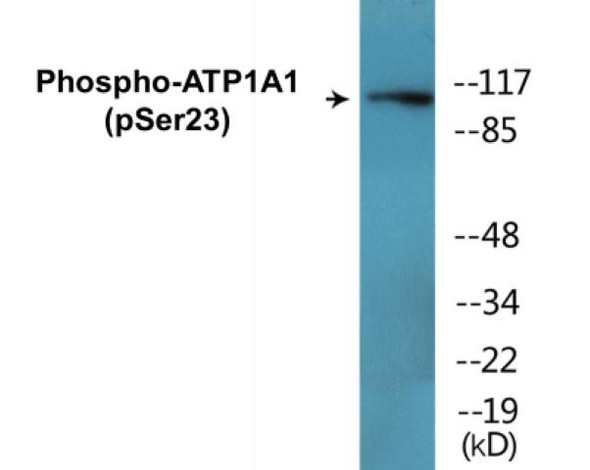Dematin (Phospho-Ser403) Colorimetric Cell-Based ELISA Kit
- SKU:
- CBCAB01416
- Product Type:
- ELISA Kit
- ELISA Type:
- Cell Based Phospho Specific
- Reactivity:
- Human
- Mouse
- Rat
- Detection Method:
- Colorimetric
Description
Dematin (Phospho-Ser403)Colorimetric Cell-Based ELISA Kit
The Dematin Phospho-Ser403 Colorimetric Cell-Based ELISA Kit is a cutting-edge tool designed for the precise detection of dematin levels in cell lysates and tissue homogenates. This innovative kit offers unparalleled sensitivity and specificity, ensuring accurate and reproducible results for a variety of research applications.Dematin, a key protein involved in cell membrane structure and function, plays a crucial role in cell adhesion, migration, and signaling pathways. Dysregulation of dematin expression has been implicated in various diseases, including cancer, inflammatory disorders, and neurodegenerative conditions, making it a valuable biomarker for studying disease mechanisms and potential therapeutic interventions.
Overall, the Dematin Phospho-Ser403 Colorimetric Cell-Based ELISA Kit is a must-have tool for researchers looking to investigate the role of dematin in cellular processes and disease pathogenesis. Its reliability and precision make it an indispensable asset for advancing scientific knowledge and discovering new therapeutic targets.
| Product Name: | Dematin (Phospho-Ser403) Colorimetric Cell-Based ELISA |
| Product Code: | CBCAB01416 |
| ELISA Type: | Cell-Based |
| Target: | Dematin (Phospho-Ser403) |
| Reactivity: | Human, Mouse, Rat |
| Dynamic Range: | > 5000 Cells |
| Detection Method: | Colorimetric 450 nm |
| Format: | 2 x 96-Well Microplates |
The Dematin (Phospho-Ser403) Colorimetric Cell-Based ELISA Kit is a convenient, lysate-free, high throughput and sensitive assay kit that can detect Dematin protein phosphorylation and expression profile in cells. The kit can be used for measuring the relative amounts of phosphorylated Dematin in cultured cells as well as screening for the effects that various treatments, inhibitors (ie. siRNA or chemicals), or activators have on Dematin phosphorylation.
Qualitative determination of Dematin (Phospho-Ser403) concentration is achieved by an indirect ELISA format. In essence, Dematin (Phospho-Ser403) is captured by Dematin (Phospho-Ser403)-specific primary (1ø) antibodies while the HRP-conjugated secondary (2ø) antibodies bind the Fc region of the 1ø antibody. Through this binding, the HRP enzyme conjugated to the 2ø antibody can catalyze a colorimetric reaction upon substrate addition. Due to the qualitative nature of the Cell-Based ELISA, multiple normalization methods are needed:
| 1. | A monoclonal antibody specific for human GAPDH is included to serve as an internal positive control in normalizing the target absorbance values. |
| 2. | Following the colorimetric measurement of HRP activity via substrate addition, the Crystal Violet whole-cell staining method may be used to determine cell density. After staining, the results can be analysed by normalizing the absorbance values to cell amounts, by which the plating difference can be adjusted. |
| Database Information: | Gene ID: 2039, UniProt ID: Q08495, OMIM: 125305, Unigene: Hs.106124/Hs.186350 |
| Gene Symbol: | EPB49 |
| Sub Type: | Phospho |
| UniProt Protein Function: | dematin: a probable DNA binding protein, with a Myb-like DNA-binding and ELM2 domain. |
| UniProt Protein Details: | Protein type:Motility/polarity/chemotaxis; Tumor suppressor; Actin-binding Chromosomal Location of Human Ortholog: 8p21.1 Cellular Component: actin cytoskeleton; actin filament; cell projection membrane; cortical cytoskeleton; cytoplasmic membrane-bound vesicle; cytosol; endomembrane system; perinuclear region of cytoplasm; plasma membrane Molecular Function:actin binding; protein binding; protein self-association; receptor binding; spectrin binding Biological Process: actin cytoskeleton organization and biogenesis; actin filament bundle formation; actin filament capping; cytoskeleton organization and biogenesis; erythrocyte development; negative regulation of focal adhesion formation; negative regulation of peptidyl-serine phosphorylation; negative regulation of peptidyl-tyrosine phosphorylation; positive regulation of blood coagulation; protein complex assembly; regulation of actin cytoskeleton organization and biogenesis; regulation of cell shape; regulation of filopodium formation; transmembrane transport |
| NCBI Summary: | The protein encoded by this gene is an actin binding and bundling protein that plays a structural role in erythrocytes, by stabilizing and attaching the spectrin/actin cytoskeleton to the erythrocyte membrane in a phosphorylation-dependent manner. This protein contains a core domain in the N-terminus, and a headpiece domain in the C-terminus that binds F-actin. When purified from erythrocytes, this protein exists as a trimer composed of two 48 kDa polypeptides and a 52 kDa polypeptide. The different subunits arise from alternative splicing in the 3' coding region, where the headpiece domain is located. Disruption of this gene has been correlated with the autosomal dominant Marie Unna hereditary hypotrichosis disease, while loss of heterozygosity of this gene is thought to play a role in prostate cancer progression. Alternative splicing results in multiple transcript variants encoding different isoforms. [provided by RefSeq, Nov 2014] |
| UniProt Code: | Q08495 |
| NCBI GenInfo Identifier: | 22654240 |
| NCBI Gene ID: | 2039 |
| NCBI Accession: | Q08495.3 |
| UniProt Secondary Accession: | Q08495,Q13215, Q9BRE3, A8K0T5, B3KP70, B3KRH3, B4DI75 E9PEJ0, |
| UniProt Related Accession: | Q08495 |
| Molecular Weight: | 41,558 Da |
| NCBI Full Name: | Dematin |
| NCBI Synonym Full Names: | dematin actin binding protein |
| NCBI Official Symbol: | DMTN |
| NCBI Official Synonym Symbols: | DMT; EPB49 |
| NCBI Protein Information: | dematin |
| UniProt Protein Name: | Dematin |
| UniProt Synonym Protein Names: | Dematin actin-binding protein; Erythrocyte membrane protein band 4.9 |
| Protein Family: | Dematin |
| UniProt Gene Name: | DMTN |
| UniProt Entry Name: | DEMA_HUMAN |
| Component | Quantity |
| 96-Well Cell Culture Clear-Bottom Microplate | 2 plates |
| 10X TBS | 24 mL |
| Quenching Buffer | 24 mL |
| Blocking Buffer | 50 mL |
| 15X Wash Buffer | 50 mL |
| Primary Antibody Diluent | 12 mL |
| 100x Anti-Phospho Target Antibody | 60 µL |
| 100x Anti-Target Antibody | 60 µL |
| Anti-GAPDH Antibody | 60 µL |
| HRP-Conjugated Anti-Rabbit IgG Antibody | 12 mL |
| HRP-Conjugated Anti-Mouse IgG Antibody | 12 mL |
| SDS Solution | 12 mL |
| Stop Solution | 24 mL |
| Ready-to-Use Substrate | 12 mL |
| Crystal Violet Solution | 12 mL |
| Adhesive Plate Seals | 2 seals |
The following materials and/or equipment are NOT provided in this kit but are necessary to successfully conduct the experiment:
- Microplate reader able to measure absorbance at 450 nm and/or 595 nm for Crystal Violet Cell Staining (Optional)
- Micropipettes with capability of measuring volumes ranging from 1 µL to 1 ml
- 37% formaldehyde (Sigma Cat# F-8775) or formaldehyde from other sources
- Squirt bottle, manifold dispenser, multichannel pipette reservoir or automated microplate washer
- Graph paper or computer software capable of generating or displaying logarithmic functions
- Absorbent papers or vacuum aspirator
- Test tubes or microfuge tubes capable of storing ≥1 ml
- Poly-L-Lysine (Sigma Cat# P4832 for suspension cells)
- Orbital shaker (optional)
- Deionized or sterile water
*Note: Protocols are specific to each batch/lot. For the correct instructions please follow the protocol included in your kit.
| Step | Procedure |
| 1. | Seed 200 µL of 20,000 adherent cells in culture medium in each well of a 96-well plate. The plates included in the kit are sterile and treated for cell culture. For suspension cells and loosely attached cells, coat the plates with 100 µL of 10 µg/ml Poly-L-Lysine (not included) to each well of a 96-well plate for 30 minutes at 37 °C prior to adding cells. |
| 2. | Incubate the cells for overnight at 37 °C, 5% CO2. |
| 3. | Treat the cells as desired. |
| 4. | Remove the cell culture medium and rinse with 200 µL of 1x TBS, twice. |
| 5. | Fix the cells by incubating with 100 µL of Fixing Solution for 20 minutes at room temperature. The 4% formaldehyde is used for adherent cells and 8% formaldehyde is used for suspension cells and loosely attached cells. |
| 6. | Remove the Fixing Solution and wash the plate 3 times with 200 µL 1x Wash Buffer for five minutes each time with gentle shaking on the orbital shaker. The plate can be stored at 4 °C for a week. |
| 7. | Add 100 µL of Quenching Buffer and incubate for 20 minutes at room temperature. |
| 8. | Wash the plate 3 times with 1x Wash Buffer for 5 minutes each time. |
| 9. | Add 200 µL of Blocking Buffer and incubate for 1 hour at room temperature. |
| 10. | Wash 3 times with 200 µL of 1x Wash Buffer for 5 minutes each time. |
| 11. | Add 50 µL of 1x primary antibodies Anti-Dematin (Phospho-Ser403) Antibody, Anti-Dematin Antibody and/or Anti-GAPDH Antibody) to the corresponding wells, cover with Parafilm and incubate for 16 hours (overnight) at 4 °C. If the target expression is known to be high, incubate for 2 hours at room temperature. |
| 12. | Wash 3 times with 200 µL of 1x Wash Buffer for 5 minutes each time. |
| 13. | Add 50 µL of 1x secondary antibodies (HRP-Conjugated AntiRabbit IgG Antibody or HRP-Conjugated Anti-Mouse IgG Antibody) to corresponding wells and incubate for 1.5 hours at room temperature. |
| 14. | Wash 3 times with 200 µL of 1x Wash Buffer for 5 minutes each time. |
| 15. | Add 50 µL of Ready-to-Use Substrate to each well and incubate for 30 minutes at room temperature in the dark. |
| 16. | Add 50 µL of Stop Solution to each well and read OD at 450 nm immediately using the microplate reader. |
(Additional Crystal Violet staining may be performed if desired – details of this may be found in the kit technical manual.)










